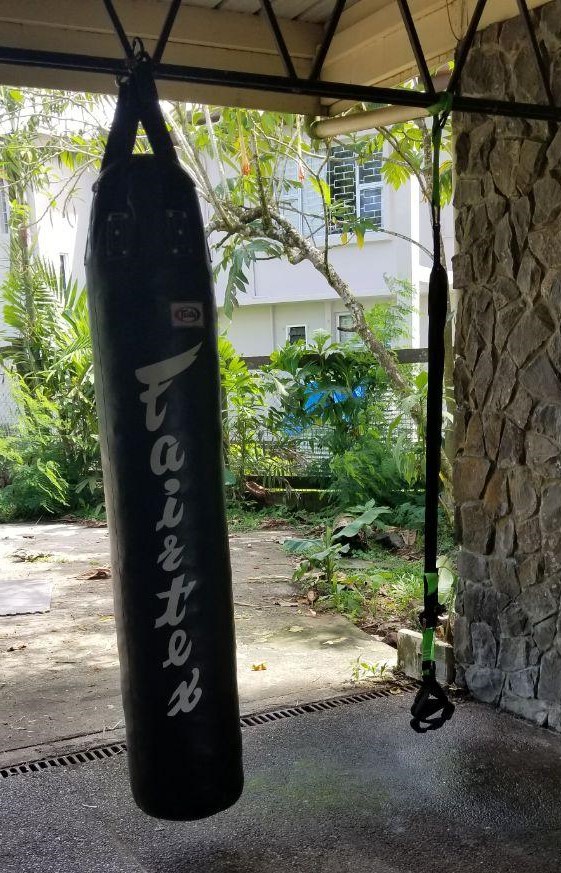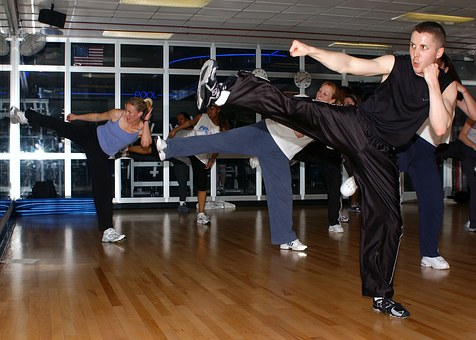Looking to develop your own kickboxing training program for home and want to know what a typical kickboxing training session looks like for you to replicate?
Then read on and by the end of this article you will be able to develop your own kickboxing training program.
This will be useful if you are interested in attending classes but would like to know what the training consists of before signing up.
Or, if you want to do kickboxing training at home, solo and need some guidance on developing a training session and program.
What is Kickboxing?
Kickboxing is a martial art that predominately utilizes striking techniques.
The commonly used strikes are punches kicks and knees.
Elbows and clinching can be included but are not focused on as much as in muay thai in comparison.
In competition depending on the particular rule set or kickboxing promotion, elbows and clinching may be not be permitted.
Kickboxing is a stand-up combat art that utilizes techniques from Western boxing, Karate and Thai boxing or muay thai.

Kickboxing or Muay Thai? Whats the difference?
There are specific differences between muay thai and kickboxing but generally speaking they are both striking dominant arts though muay thai does have more of a grappling aspect in the clinch.
Depending on the rule set of the tournament or promotion, elbows and clinching may or may not be allowed.
For the sake of this post we will look at all eight limbs (hands, knees, elbows and legs) in developing a kickboxing training routine.
However in kickboxing events different rule sets may apply that limit or completely ban elbows and clinching.
How to train kickboxing
A typical kickboxing routine or session, if in a gym or even training solo would look very much like a typical Western boxing session.
For example beginning with some skipping then shadow boxing, moving on to some bag work, pads with a trainer/partner and some partner drills or sparring.
When starting out as a beginner or for a routine to train kickboxing solo at home, a simple but very effective routine if done consistently for beginners should include the aspects below:
- Skipping – one to three rounds
- Shadowboxing – two to three rounds
- Heavy bag – two to three rounds
- Pads – two to three rounds
- Partner drills – one to three rounds
- Conditioning – 10 – 15 mins at the end
A round of training for this type of training would be three minutes with 60-90 sec rest between rounds.
Bag Work
A heavy bag is essential to kickboxing training.
This is especially so if you are training solo at home. I would recommend another 3-5 rounds of heavy bag work after your skipping and shadow boxing.
With the heavy bag it is a good tool to focus on your power, especially for kicks.
But if you are mostly training at home, solo then you need to vary your heavy bag training. Sometimes working on power and other time focusing on technique and also speed.
Have a look at this post for a technique based heavy bag workout you can use to vary your heavy bag training to focus on different aspects.
Make sure you are tucking your chin and have your guard up when kicking to protect your face.

After you throw a kick or punch on the heavy bag always get back to ready position right away and be ready to defend and move again quickly.
If you are looking for a more comprehensive and full heavy bag program to follow I would recommend checking out Sean ‘Muay Thai Guy’ Fagan’s Heavy Bag Blueprint.
You can read my Review of the Heavy Bag Blueprint and access a 50% discount.
Pad Work
You will need someone to hold the thai pads for you and preferably someone with a little bit of experience in holding pads and catching strikes.
3-5 rounds drilling specific combos would be advisable.
With pads you can still focus a bit on power but use the pads more for your accuracy, timing and movement.
Partner drills
You will need shin pads for this part.
Partner drills are really great as you are able to get a feel for the distance and timing aspects of kickboxing.

They teach you how to move in relation to a live partner and also allow you to practice your defense more so than heavy bag and pad work.
These partner drills basically originated from Dutch kickboxing and often referred to as Dutch drills.
Conditioning
Here you can finish up with some body weight exercises like push ups and sit ups, pull ups and squats or any conditioning methods you favor.
In a typical kickboxing session you may usually finish up with burn out drills and exercises with a partner or on the bag. See one example of a good burnout drill below.
Burnout Drill: 30 sec punch out Mountain climbers for 30 sec 10 Burpees
Another good burn out type drill is to pyramid up or down kicks on both legs. Starting from 1 on each leg. Then 2 on each leg and so on all the way up to 10 consecutive kicks on each leg.
Kickboxing Training : Final thoughts
Overall kickboxing as a term encompasses many styles and martial arts.
These can be traced back to Japanese karate, western boxing, muay thai combined together in a hybrid form of stand up striking art.
In terms of training the elements are similar to western boxing as outlined in this article.
The good thing about kickboxing is you can start to learn and practice from home.

With some basic equipment such as a heavy bag and gloves you can get going without too much complexity and start your own kickboxing training at home.
There are many resources on the web and YouTube that you can use to develop your own kickboxing training routine, though a basic outline has been provided above for you to get started with asap.



